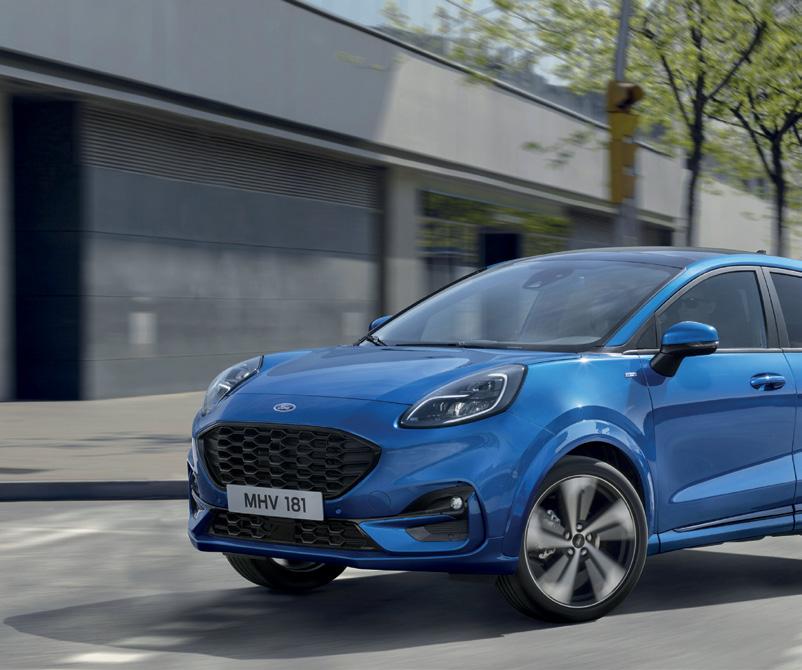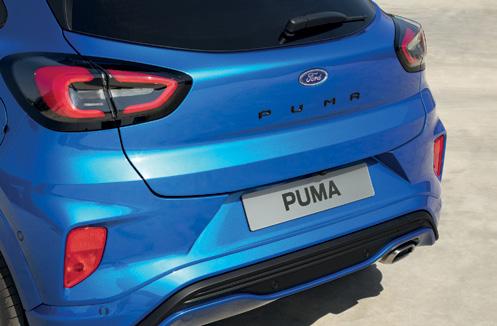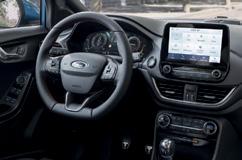
4 minute read
REVIEWED: FORD'S NEW PUMA.
R U A NINETIES BABY?R U A NINETIES BABY?
It’s well and truly a sign of how both fashions and buying habits change that when Ford decided to reimagine its iconic Puma coupe from the mid 90s that it updated the concept from coupe to crossover.
The original Puma proved itself a marvel on the road with slick handling, excellent roadholding and peppy performance from its 1.7 petrol engine. It’s the one car I regret not buying; walking away from the dealerships to put down a deposit instead on a sexy little Alfa 145 Cloverleaf that, of course, spent more time in the service bay than it did on the road and lost all of its considerable value literally overnight. Heart literally stomped over head.
32 dluxe-magazine.co.uk looks back to the original couple, especially in those headlights but also represents the next chapter in Ford’s design philosophy so expect some pretty new cars to come. A low, sloping roofline gives a dramatic, instantly recognisable silhouette, and bucks the trend for wedge-style crossover side profiles. This “anti-wedge” design features a flatter belt-line to deliver balanced proportions and succeeds in stopping the Puma from appearing slabby.
Pronounced wheel arches amplify the sporty character as do the front air curtain inlets that guide airflow across the front wheels to reduce turbulence for improved aerodynamics and a large rear wing, wide tail lights and central Puma branding give what could be a heavy back end a squat and powerful presence.
That back end hides best-in-class load space and luggage capacity of 456 litres and features an adjustable boot floor and Megabox storage space. The storage solution offers a capacity of 80 litres in a space which can house unstable items up to around 115 cm tall – such as houseplants – in an upright position. Alternatively, with the lid down, the space can be used to conceal dirty sports equipment or muddy Wellington boots. The synthetic lining and drain plug in the bottom of the Ford Megabox makes it easy to clean with water- clever.
Loading the Puma is made even easier thanks to a hands-free tailgate technology opening that you’d normally find on high end Mercedes models. The system allows access to the boot space even with arms full of groceries, kids or sports equipment, using a simple kicking motion under the rear bumper.
R U A NINETIES BABY?R U A NINETIES BABY?

seats a first in the segment and a full-length openable panorama roof comprising two almost-full width panes of toughened, tinted glass creates an even more spacious and airy feel for occupants in the front and rear.

Opt for the ST-Line or ST-Line X and enjoy a fully configurable digital instrument cluster using “true colour” display technology so it’s bright without being tiring on the eyes and easy to read. There’s a wireless charging pad built in for effortlessly recharging smartphones on the move and devices can remain linked via Bluetooth to the communications and entertainment system whilst wireless charging, allowing Puma drivers to control audio, navigation and connected smartphones using simple voice commands.
Available in Titanium, ST-Line and STLine X trims, the higher spec models add 18-inch standard or 19-inch optional matt black machined alloy wheels and a sports suspension with specially tuned springs and shock absorbers. At the front, the ST-Line grille features matt black elements and a high-gloss surround, high-gloss foglamp surrounds, and an optional larger, functional roof-spoiler along with bold signature STLine lower wing elements direct air to the air-curtain inlets. Inside, the Puma ST Line features a flat-bottomed steering wheel and old school red stitching – also available on the optional partial leather seats. Colours are somewhat sedate with the standard, blues, black, red white and grey on offer.


Like the original before it, this Puma is also based on the platform of its Fiesta sibling and features Ford’s EcoBoost Hybrid 48- volt technology to enhance fuel efficiency, performance and the Puma’s fun-to-drive character. The mild-hybrid powertrain seamlessly integrates electric torque assistance with a low-friction, three-cylinder 1.0 litre EcoBoost petrol engine to deliver up to 155 PS.
Offered in 125 PS and 155 PS variants, the intelligent, self-regulating mild-hybrid system continuously monitors how the vehicle is being used to determine when and how intensively to charge the battery for optimal benefit. The electric torque assistance helps deliver punchier, more responsive performance, with up to 50 per cent more torque available at lower engine speeds, for a more flexible and connected driving experience.
For those not wanting to opt for hybrid, a range of petrol and diesel engines are available alongside an impressive list of safety tech. Puma utilises 12 ultrasonic sensors, three radars and two cameras positioned around the car to enhance protection, driving and parking, and are designed to make the driving experience more comfortable, less demanding and safer.
Adaptive Cruise Control with Stop & Go, Speed Sign Recognition and Lane Centring helps the vehicle maintain a comfortable driving distance from vehicles ahead and new Local Hazard Information functionality – enabled by the FordPass Connect on-board modem – can inform drivers of a hazardous situation on the road ahead, even if the incident is not visible due to a bend in the road or other vehicles.
So bigger, better equipped, more practical, more efficient and with more safety equipment fitted as standard but still as good to drive; it looks like the Puma has come a long way from its 90s roots. Like all of us, it’s grown up. Perhaps it’s time to revisit that Ford dealership.










